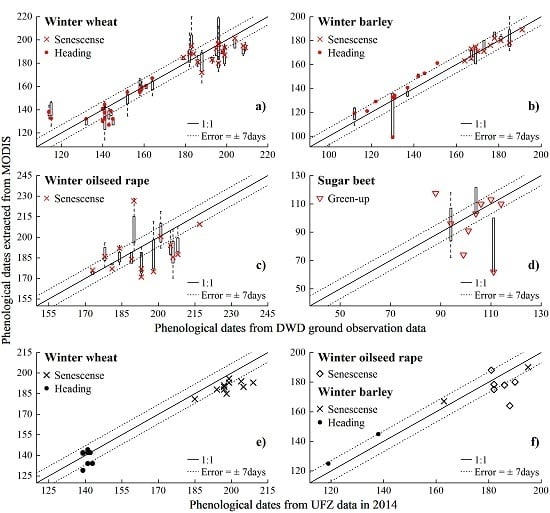Optimising Phenological Metrics Extraction for Different Crop Types in Germany Using the Moderate Resolution Imaging Spectrometer (MODIS)
Abstract
:1. Introduction
- (1).
- to systematically optimise the derivation of phenometrics from MODIS Normalized Difference Vegetation Index (NDVI) time series in terms of the BISE sliding period, smoothing algorithms and thresholds for four major crops (winter wheat, winter barley, oilseed rape, and sugar beet) in central Germany;
- (2).
- to calibrate and validate satellite-derived phenometrics with field-observed phenostages of different crop types (e.g., emergence, heading, and yellow ripeness for winter cereals; emergence and full ripeness for oilseed rape; emergence for sugar beet).
2. Materials and Methods
2.1. Study Area
2.2. MODIS Data
2.3. Field Phenology Data and Ancillary Data
2.4. Phenometrics Extraction
2.4.1. NDVI Time-Series Construction
2.4.2. Calibration and Validation of the Phenometrics
- smoothed maximal NDVI cannot occur within 60 days of start and end of one calendar year;
- the green-up of sugar beet cannot occur after Julian date 195 of one calendar year (around mid-July);
- senescence cannot occur before Julian date 135 of one calendar year (around mid-May);
- for the green-up of winter crops, smoothed minimum NDVI should be searched only from Julian date 220 to 280 (mid-July to early October), and smoothed maximum NDVI cannot occur in December.
3. Results
3.1. Method Comparison and Parameter Calibration
3.2. Calibration Results Using the Savitzky-Golay Filter
3.3. Validation Results Using the Savitzky–Golay Filter
3.4. Phenometrics at Regional Scale
4. Discussion
4.1. Noise Reduction of NDVI Time Series
4.2. Validation with Ground Observations
4.3. Phenometrics Extraction
5. Conclusions
Acknowledgments
Author Contributions
Conflicts of Interest
References
- Moran, M.S.; Inoue, Y.; Barnes, E.M. Opportunities and limitations for image-based remote sensing in precision crop management. Remote Sens. Environ. 1997, 61, 319–346. [Google Scholar] [CrossRef]
- Thenkabail, P.S. Global croplands and their importance for water and food security in the twenty-first century: Towards an ever green revolution that combines a second green revolution with a blue revolution. Remote Sens. 2010, 2, 2305–2312. [Google Scholar] [CrossRef]
- Fischer, A. A model for the seasonal-variations of vegetation indexes in coarse resolution data and its inversion to extract crop parameters. Remote Sens. Environ. 1994, 48, 220–230. [Google Scholar] [CrossRef]
- Marinho, E.; Vancutsem, C.; Fasbender, D.; Kayitakire, F.; Pini, G.; Pekel, J.-F. From Remotely Sensed Vegetation Onset to Sowing Dates: Aggregating Pixel-Level Detections into Village-Level Sowing Probabilities. Remote Sens. 2014, 6, 10947–10965. [Google Scholar] [CrossRef]
- Simms, D.M.; Waine, T.W.; Taylor, J.C.; Juniper, G.R. The application of time-series MODIS NDVI profiles for the acquisition of crop information across Afghanistan. Int. J. Remote Sens. 2014, 35, 37–41. [Google Scholar] [CrossRef]
- Sehgal, V.K.; Jain, S.; Aggarwal, P.K.; Jha, S. Deriving Crop Phenology Metrics and Their Trends Using Times Series NOAA-AVHRR NDVI Data. J. Indian Soc. Remote Sens. 2011, 39, 373–381. [Google Scholar] [CrossRef]
- Wardlow, B.D.; Kastens, J.H.; Egbert, S.L. Using USDA crop progress data for the evaluation of greenup onset date calculated from MODIS 250-meter data. Photogramm. Eng. Remote Sens. 2006, 72, 1225–1234. [Google Scholar] [CrossRef]
- Myneni, R.B.; Hall, F.G.; Sellers, P.J.; Marshak, A.L. Interpretation of spectral vegetation indexes. IEEE Trans. Geosci. Remote Sens. 1995, 33, 481–486. [Google Scholar] [CrossRef]
- Bauer, M.E. Spectral Inputs to Crop Identification and Condition Assessment. Proc. IEEE 1985, 73, 1071–1085. [Google Scholar] [CrossRef]
- Sakamoto, T.; Yokozawa, M.; Toritani, H.; Shibayama, M.; Ishitsuka, N.; Ohno, H. A crop phenology detection method using time-series MODIS data. Remote Sens. Environ. 2005, 96, 366–374. [Google Scholar] [CrossRef]
- Domínguez, J.A.; Kumhálová, J.; Novák, P. Winter oilseed rape and winter wheat growth prediction using remote sensing methods. Plant Soil Environ. 2015, 61, 410–416. [Google Scholar]
- Pan, Z.; Huang, J.; Zhou, Q.; Wang, L.; Cheng, Y.; Zhang, H.; Blackburn, G.A.; Yan, J.; Liu, J. Mapping crop phenology using NDVI time-series derived from HJ-1 A/B data. Int. J. Appl. Earth Obs. Geoinf. 2015, 34, 188–197. [Google Scholar] [CrossRef]
- Herbek, J.; Lee, C. A Comprehensive Guide to Wheat Management in Kentucky; University of Kentucky College of Agriculture: Lexington, KY, USA, 2009. [Google Scholar]
- Holben, B.N. Characteristics of maximum-value composite images from temporal AVHRR data. Int. J. Remote Sens. 1986, 7, 1417–1434. [Google Scholar] [CrossRef]
- Viovy, N.; Arino, O.; Belward, A. S. The Best Index Slope Extraction (BISE): A method for reducing noise in NDVI time-series. Int. J. Remote Sens. 1992, 13, 1585–1590. [Google Scholar] [CrossRef]
- Chen, J.; Jönsson, P.; Tamura, M.; Gu, Z.; Matsushita, B.; Eklundh, L. A simple method for reconstructing a high-quality NDVI time-series data set based on the Savitzky-Golay filter. Remote Sens. Environ. 2004, 91, 332–344. [Google Scholar] [CrossRef]
- Savitzky, A.; Golay, M.J.E. Smoothing and Differentiation of Data by Simplified Least Squares Procedures. Anal. Chem. 1964, 36, 1627–1639. [Google Scholar] [CrossRef]
- Zhu, W.; Pan, Y.; He, H.; Wang, L.; Mou, M.; Liu, J. A changing-weight filter method for reconstructing a high-quality NDVI time series to preserve the integrity of vegetation phenology. IEEE Trans. Geosci. Remote Sens. 2012, 50, 1085–1094. [Google Scholar] [CrossRef]
- De Beurs, K.M.; Henebry, G.M. Spatio-temporal statistical methods for modelling land surface phenology. In Phenological Research: Methods for Environmental and Climate Change Analysis; Springer: Berlin/Heidelberg, Germany, 2010; pp. 177–208. [Google Scholar]
- Zhao, H.; Yang, Z.; Di, L.; Li, L.; Zhu, H. Crop phenology date estimation based on NDVI derived from the reconstructed MODIS daily surface reflectance data. In Proceedings of the 2009 17th International Conference on Geoinformatics, Fairfax, VA, USA, 12–14 August 2009; pp. 1–6.
- Zhang, X.; Friedl, M.A.; Schaaf, C.B.; Strahler, A.H.; Hodges, J.C.F.; Gao, F.; Reed, B.C.; Huete, A. Monitoring vegetation phenology using MODIS. Remote Sens. Environ. 2003, 84, 471–475. [Google Scholar] [CrossRef]
- Vyas, S.; Nigam, R.; Patel, N.K.; Panigrahy, S. Extracting Regional Pattern of Wheat Sowing Dates Using Multispectral and High Temporal Observations from Indian Geostationary Satellite. J. Indian Soc. Remote Sens. 2013, 41, 855–864. [Google Scholar] [CrossRef]
- Yang, H.; Li, Z.; Chen, E.; Zhao, C.; Yang, G.; Casa, R.; Pignatti, S.; Feng, Q. Temporal polarimetric behavior of oilseed rape (Brassica napus L.) at c-band for early season sowing date monitoring. Remote Sens. 2014, 6, 10375–10394. [Google Scholar] [CrossRef]
- Zhang, Z.; Song, X.; Chen, Y.; Wang, P.; Wei, X.; Tao, F. Dynamic variability of the heading–flowering stages of single rice in China based on field observations and NDVI estimations. Int. J. Biometeorol. 2015, 59, 643–655. [Google Scholar] [CrossRef] [PubMed]
- Sakamoto, T.; Wardlow, B.D.; Gitelson, A.A.; Verma, S.B.; Suyker, A.E.; Arkebauer, T.J. A Two-Step Filtering approach for detecting maize and soybean phenology with time-series MODIS data. Remote Sens. Environ. 2010, 114, 2146–2159. [Google Scholar] [CrossRef]
- Zeng, L.; Wardlow, B.D.; Wang, R.; Shan, J.; Tadesse, T.; Hayes, M.J.; Li, D. A hybrid approach for detecting corn and soybean phenology with time-series MODIS data. Remote Sens. Environ. 2016, 181, 237–250. [Google Scholar] [CrossRef]
- Siebert, S.; Ewert, F. Spatio-temporal patterns of phenological development in Germany in relation to temperature and day length. Agric. For. Meteorol. 2012, 152, 44–57. [Google Scholar] [CrossRef]
- Rouse, J.W.; Hass, R.H.; Schell, J.A.; Deering, D.W. Monitoring vegetation systems in the great plains with ERTS. Third Earth Resour. Technol. Satell. Symp. 1973, 1, 309–317. [Google Scholar]
- Geng, L.; Ma, M.; Yu, W.; Wang, X.; Jia, S. Validation of the MODIS NDVI products in different land-use types using in situ measurements in the heihe river basin. IEEE Geosci. Remote Sens. Lett. 2014, 11, 1649–1653. [Google Scholar] [CrossRef]
- Hall, D.K.; Riggs, G.A. Accuracy assessment of the MODIS snow products. Hydrol. Process. 2007, 21, 1534–1547. [Google Scholar] [CrossRef]
- Deutscher Wetterdienst Aktueller Stand der Phänologie in Deutschland. Available online: ftp://ftp-cdc.dwd.de/pub/CDC/observations_germany/phenology/annual_reporters/crops/recent/ (accessed on 9 January 2015).
- Meier, U.; Bleiholder, H.; Buhr, L.; Feller, C.; Hack, H.; Heß, M.; Lancashire, P.; Schnock, U.; Stauß, R.; van den Boom, T.; et al. The BBCH system to coding the phenological growth stages of plants-history and publications. J. Kulturpflanzen 2009, 61, 41–52. [Google Scholar]
- Lange, M.; Doktor, D. R-Package “phenex”—Auxiliary Functions for Phenological Data Analysis. Available online: http://cran.r-project.org/web/packages/phenex/ (accessed on 8 June 2014).
- Press, W.H.; Teukolsky, S.A.; Vetterling, W.T.; Flannery, B.P. Numerical Recipes in C: The Art of Scientific Computing, 2nd ed.; Cambridge University Press: Cambridge, UK, 1992. [Google Scholar]
- Di, L.; Yu, E.G.; Yang, Z.; Shrestha, R.; Kang, L.; Zhang, B.; Sw, I.A. Remote sensing based crop growth stage estimation model. In Proceedings of the 2015 IEEE International Geoscience and Remote Sensing Symposium (IGARSS), Milan, Italy, 26–31 July 2015; pp. 2739–2742.
- Kotsuki, S.; Tanaka, K. SACRA-a method for the estimation of global high-resolution crop calendars from a satellite-sensed NDVI. Hydrol. Earth Syst. Sci. 2015, 19, 4441–4461. [Google Scholar] [CrossRef]
- Lobell, D.B.; Ortiz-Monasterio, J.I.; Sibley, A.M.; Sohu, V.S. Satellite detection of earlier wheat sowing in India and implications for yield trends. Agric. Syst. 2013, 115, 137–143. [Google Scholar] [CrossRef]
- Wang, J.; Huang, J.; Wang, X.; Jin, M.; Zhou, Z.; Guo, Q.; Zhao, Z.; Huang, W.; Zhang, Y.; Song, X. Estimation of rice phenology date using integrated HJ-1 CCD and Landsat-8 OLI vegetation indices time-series images. J. Zhejiang Univ. Sci. B 2015, 16, 832–844. [Google Scholar] [PubMed]
- Jiang, Z.; Huete, A.R.; Kim, Y.; Didan, K. 2-band Enhanced Vegetation Index without a blue band and its application to AVHRR data. In Remote Sensing and Modeling of Ecosystems for Sustainability IV; SPIE: Bellingham, WA, USA, 2007; Volume 6679, p. 667905. [Google Scholar]
- Gitelson, A.A. Wide Dynamic Range Vegetation Index for remote quantification of biophysical characteristics of vegetation. J. Plant Physiol. 2004, 161, 165–173. [Google Scholar] [CrossRef] [PubMed]
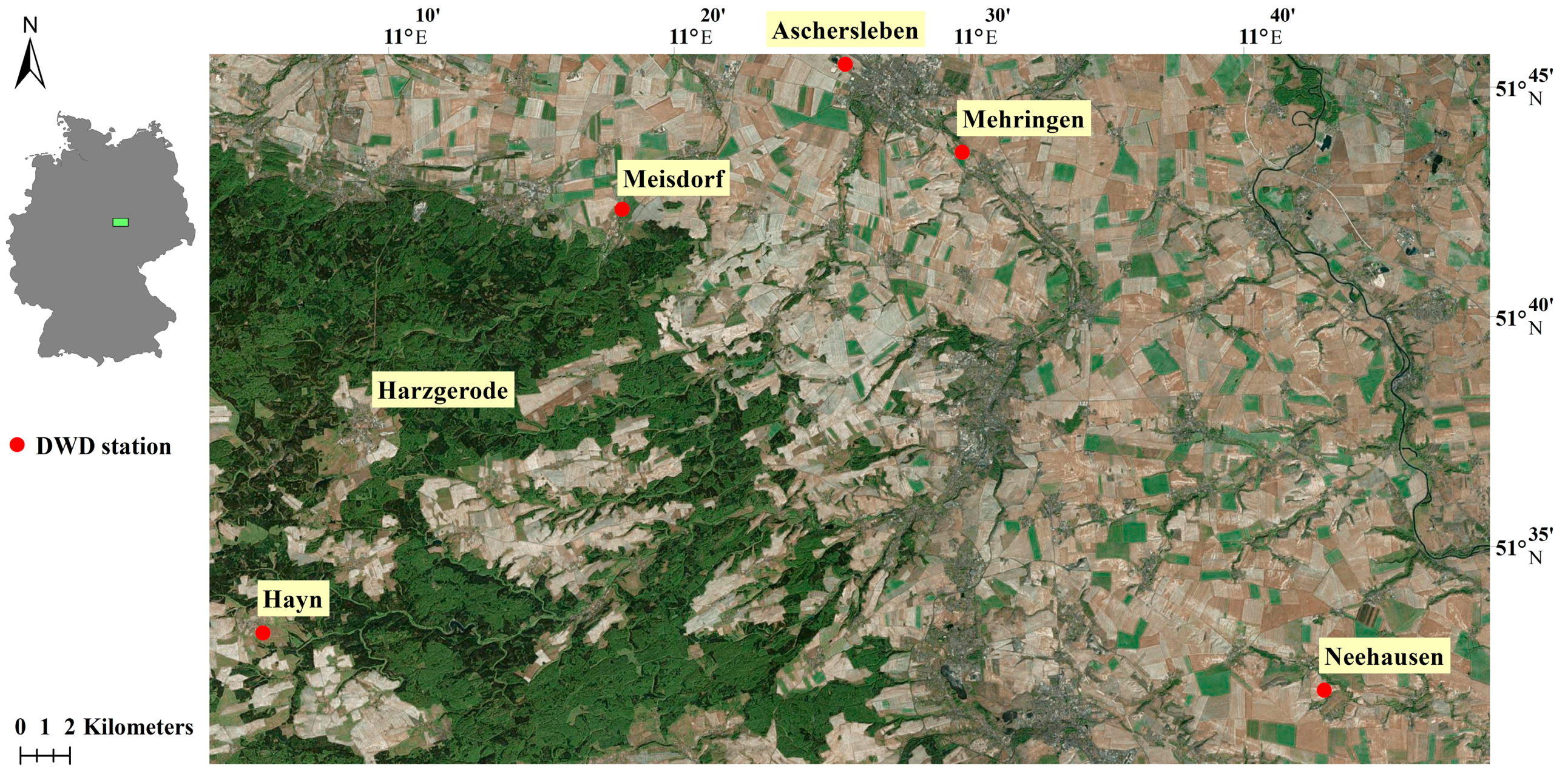
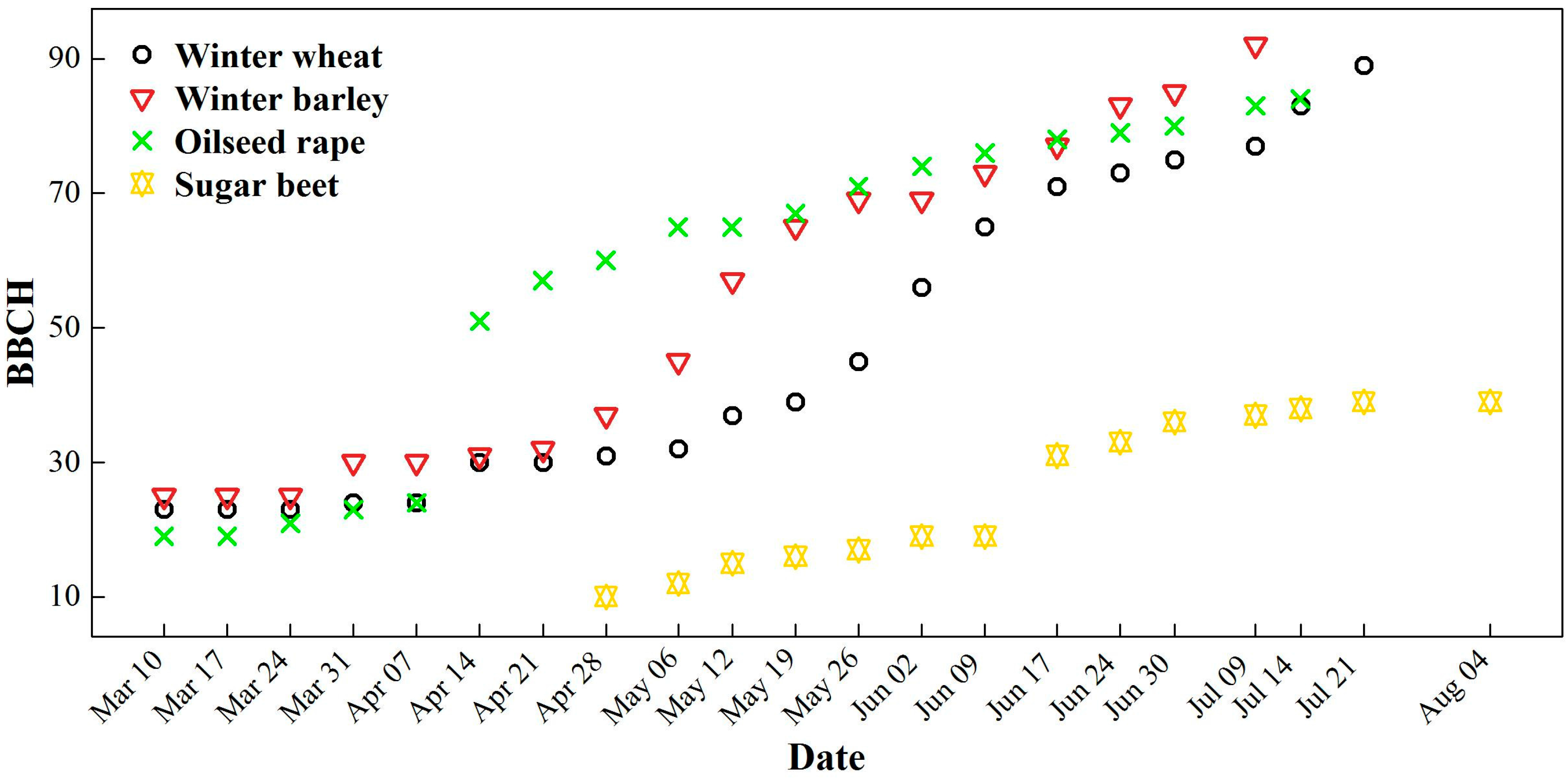

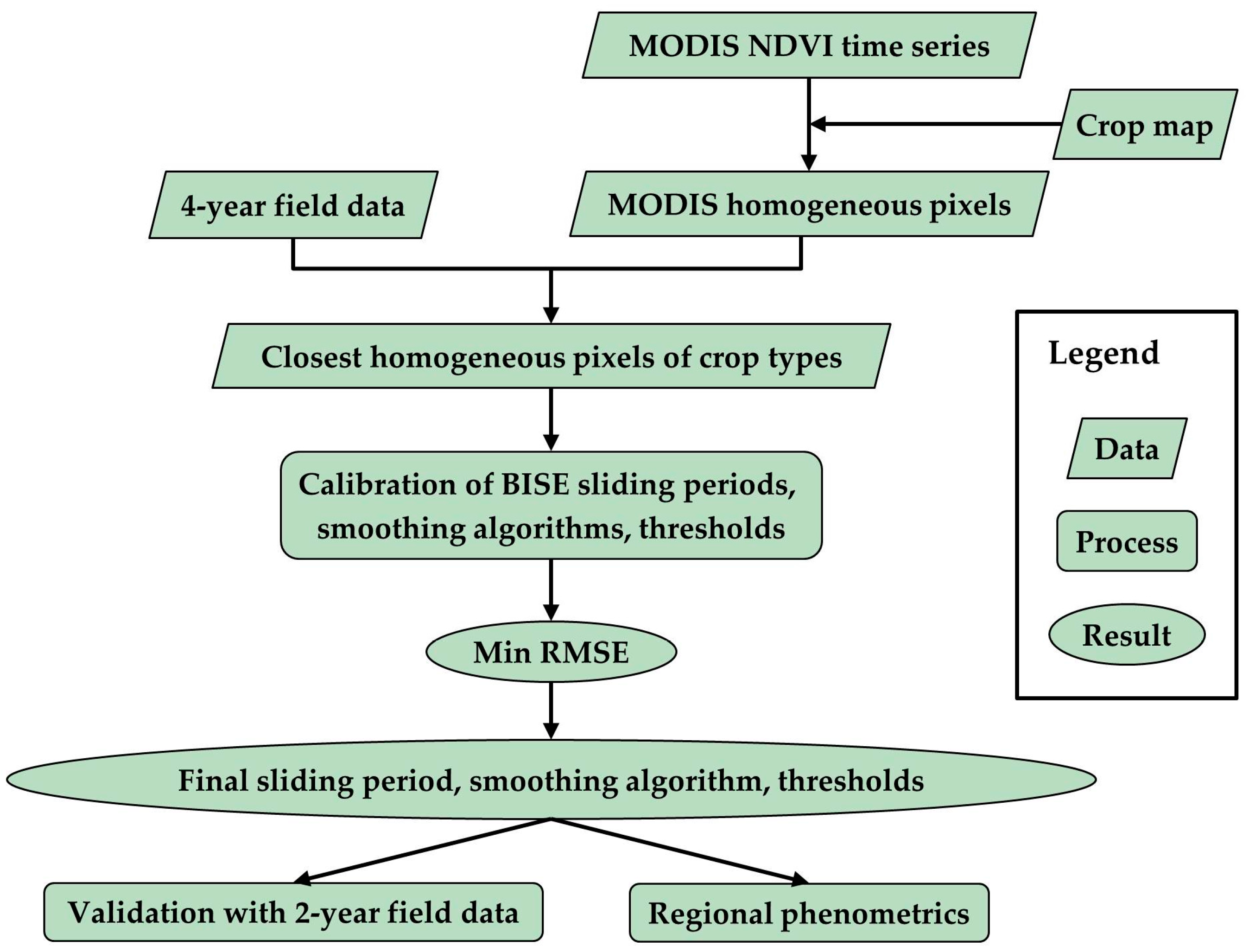
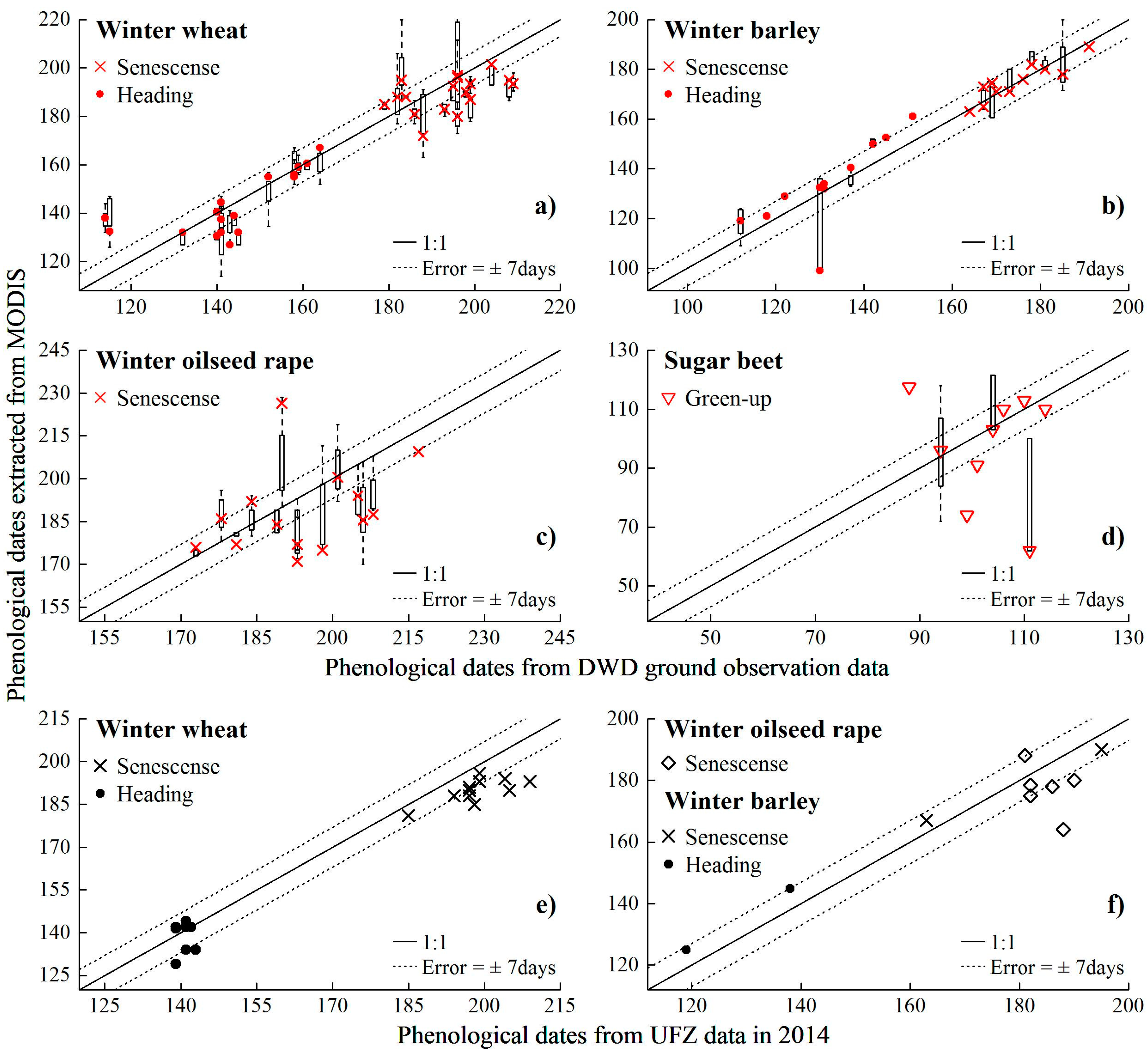
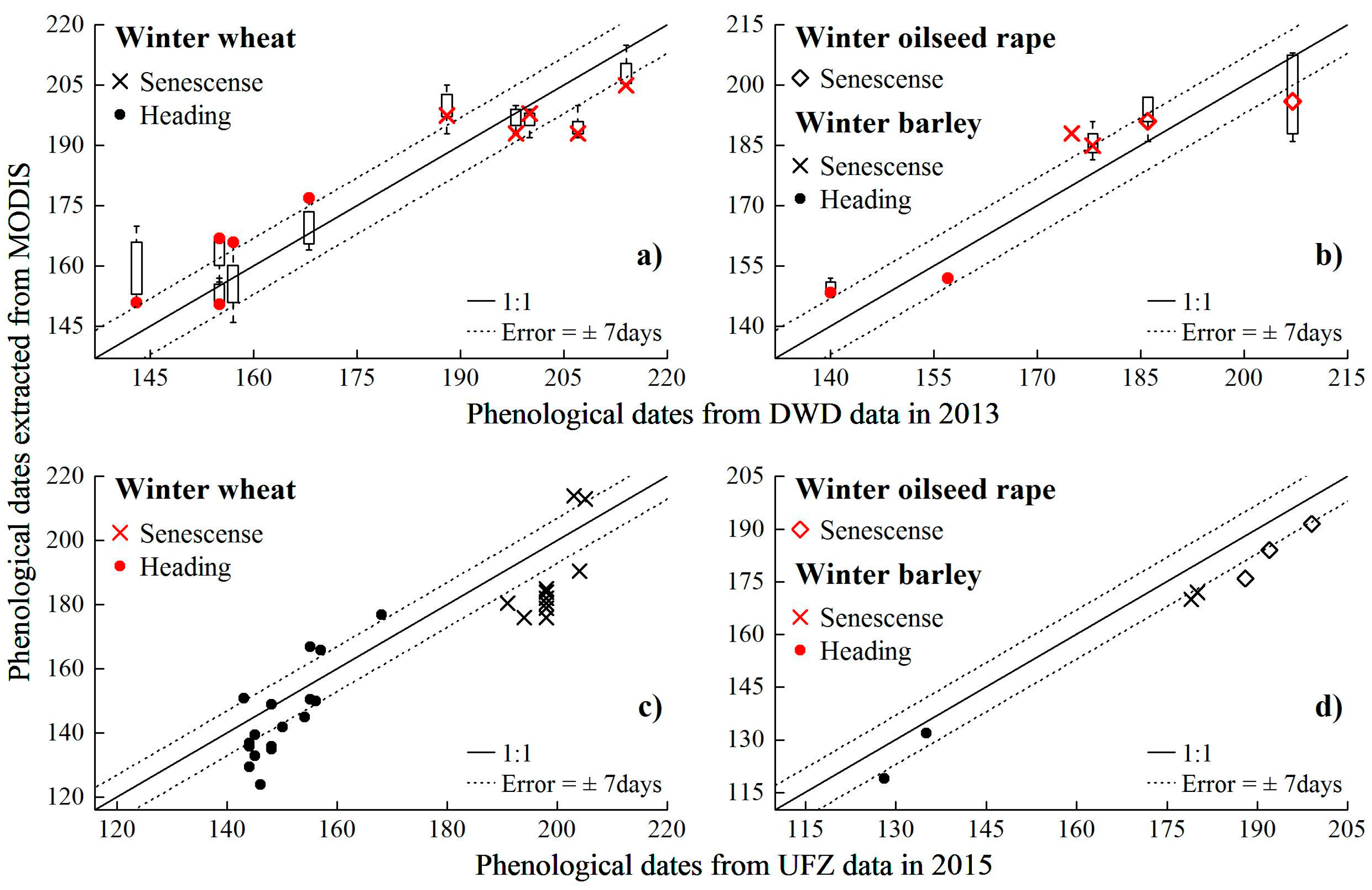
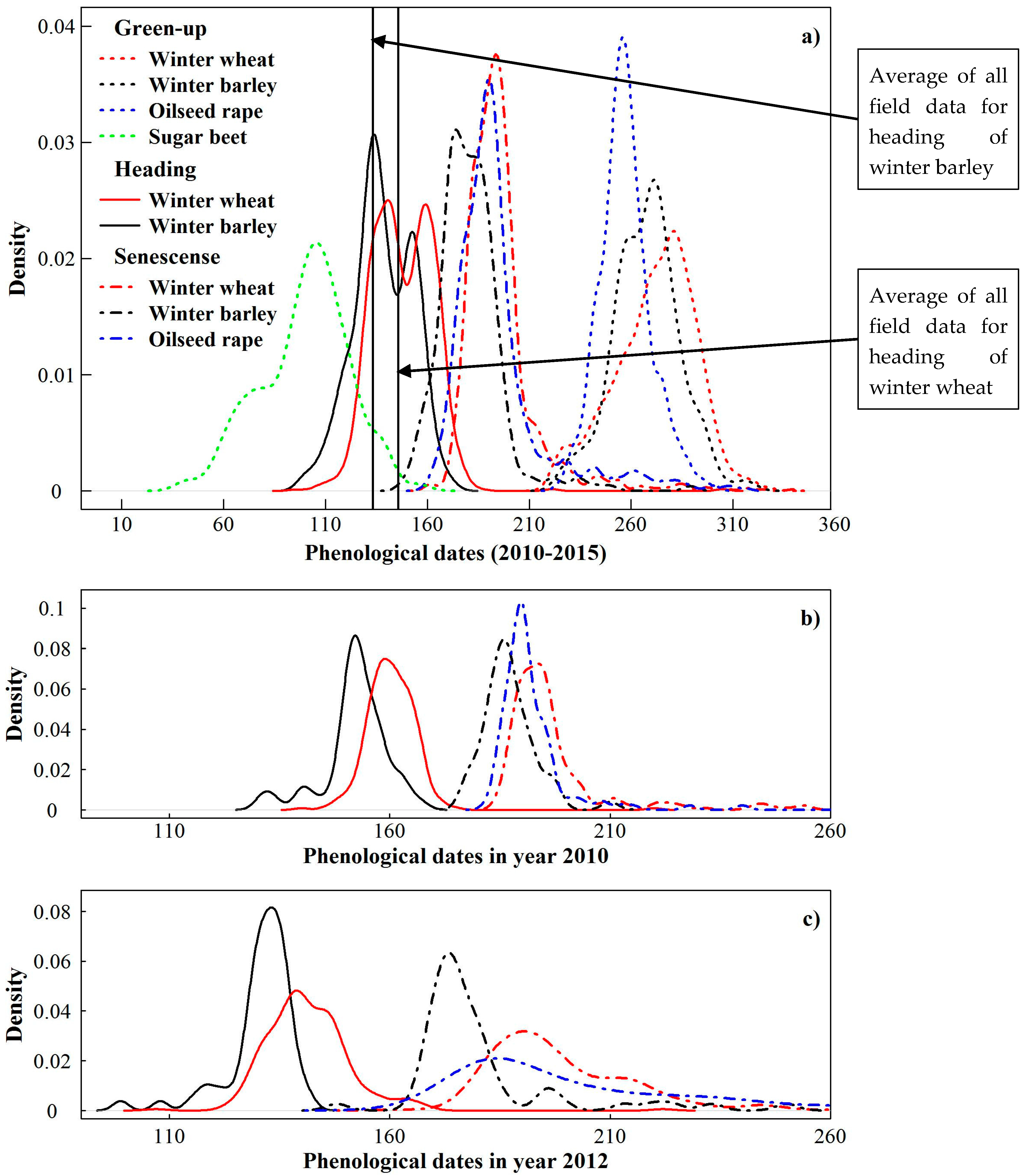
| Crop | DWD Stage ID | DWD Stage | BBCH | Stage Description |
|---|---|---|---|---|
| Winter wheat/barley | 12 | emergence | 10 | The first leaf emerges from the coleoptile and the rows of plants are already visible |
| 18 | heading | 51 | Tip of inflorescence emerged from sheath, first spikelet just visible | |
| 21 | yellow ripeness | −87 1 | The first grains have finished changing their colour from green to yellow and can be removed easily from the ear. The individual grains can be broken over the thumbnail, and the contents of the grains are plastic to hard. | |
| Oilseed rape | 12 | emergence | 10 | The plants have broken through the surface of the soil and have reached a height of approximately 1 cm |
| 22 | full ripeness | −87 1 | Most of the rape grains are black on one side | |
| Sugar beet | 12 | emergence | 10 | First leaf visible: cotyledons horizontally unfolded |
| Method | Method Settings | Sliding Period (Days) | Phenometrics | Local Threshold | RMSE | |
|---|---|---|---|---|---|---|
| Winter Crops | Sugar Beet | (Days) | ||||
| SG | d = 2; m = 5 | 21 | green-up | 0.10 | 0.29 | 12.76 |
| senescence | 0.41 | |||||
| Linear | 23 | green-up | 0.17 | 0.30 | 13.76 | |
| senescence | 0.5 | |||||
| FFT | s = 1 | 28 | green-up | 0.12 | 0.26 | 13.96 |
| senescence | 0.48 | |||||
| Spline | 31 | 15.91 | ||||
| RMSE (Days) | Year | Green-Up | Heading | Senescence | |||
|---|---|---|---|---|---|---|---|
| Winter wheat | 2010–2012, 2014 | 17.61 | (14) | 8.52 | (25) | 9.43 | (29) |
| Winter barley | 2010–2012, 2014 | 15.67 | (10) | 10.38 | (13) | 3.80 | (13) |
| Oilseed rape | 2010–2012, 2014 | 13.20 | (17) | 15.24 | (20) | ||
| Sugar beet | 2010–2012, 2014 | 21.19 | (9) | ||||
| RMSE (Days) | Year | Green-Up | Heading | Senescence | |||
|---|---|---|---|---|---|---|---|
| Winter wheat | 2013, 2015 | 20.37 | (6) | 10.48 | (17) | 13.59 | (17) |
| Winter barley | 2013, 2015 | 6.17 | (2) | 6.84 | (4) | 9.53 | (4) |
| Oilseed rape | 2013, 2015 | 5.10 | (2) | 9.06 | (5) | ||
| Sugar beet | 2013, 2015 | 14.17 | (4) | ||||
© 2017 by the authors. Licensee MDPI, Basel, Switzerland. This article is an open access article distributed under the terms and conditions of the Creative Commons Attribution (CC BY) license ( http://creativecommons.org/licenses/by/4.0/).
Share and Cite
Xu, X.; Conrad, C.; Doktor, D. Optimising Phenological Metrics Extraction for Different Crop Types in Germany Using the Moderate Resolution Imaging Spectrometer (MODIS). Remote Sens. 2017, 9, 254. https://doi.org/10.3390/rs9030254
Xu X, Conrad C, Doktor D. Optimising Phenological Metrics Extraction for Different Crop Types in Germany Using the Moderate Resolution Imaging Spectrometer (MODIS). Remote Sensing. 2017; 9(3):254. https://doi.org/10.3390/rs9030254
Chicago/Turabian StyleXu, Xingmei, Christopher Conrad, and Daniel Doktor. 2017. "Optimising Phenological Metrics Extraction for Different Crop Types in Germany Using the Moderate Resolution Imaging Spectrometer (MODIS)" Remote Sensing 9, no. 3: 254. https://doi.org/10.3390/rs9030254
APA StyleXu, X., Conrad, C., & Doktor, D. (2017). Optimising Phenological Metrics Extraction for Different Crop Types in Germany Using the Moderate Resolution Imaging Spectrometer (MODIS). Remote Sensing, 9(3), 254. https://doi.org/10.3390/rs9030254





